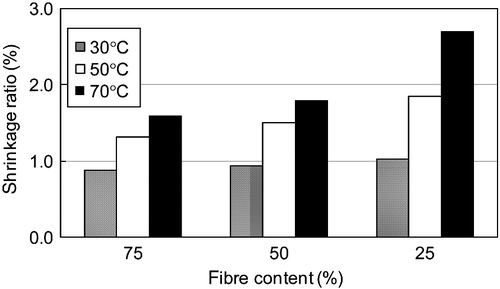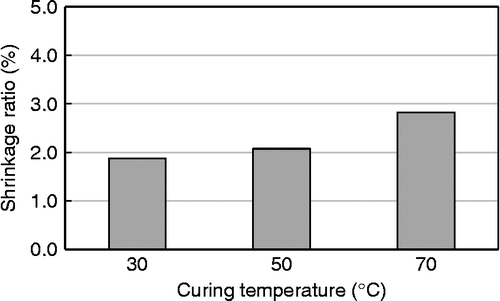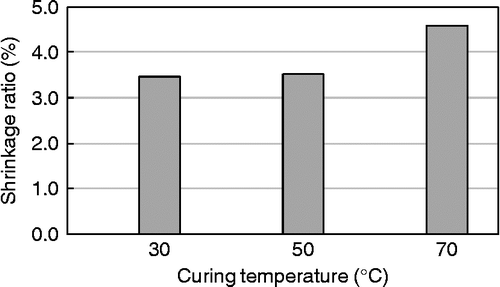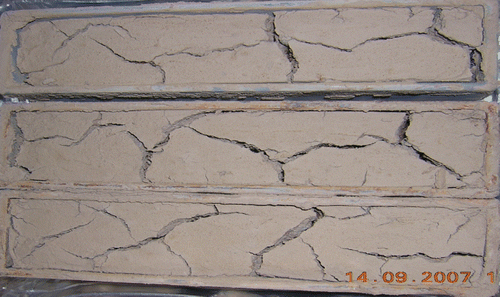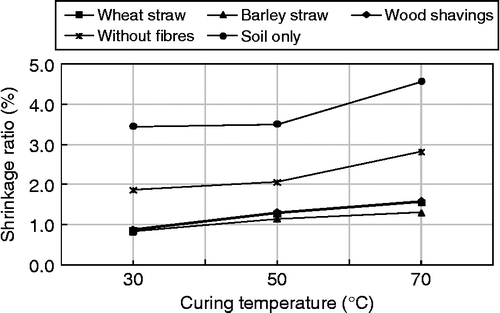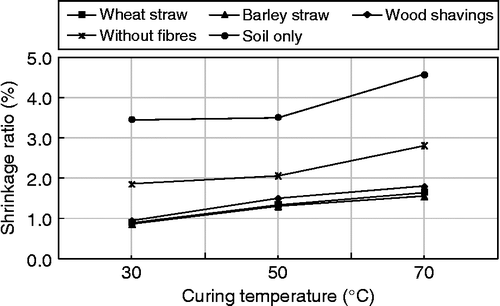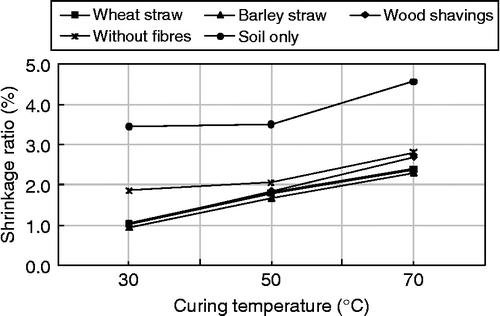Abstract
In this paper, a series of laboratory tests on shrinkage of plaster materials are presented. The plaster materials consist of cohesive soil, sand and different natural fibres. Three types of fibres, wheat straw, barley straw and wood shavings, were used as reinforcement in the tests. The shrinkage behaviour of earth plasters was studied by laboratory tests for different compositions and under different curing conditions. The specimens of plaster material were dried under a constant temperature of 30, 50 and 70°C, respectively. The effect of the following factors on shrinkage was investigated: temperature, soil composition, fibre type and fibre content. It was established that shrinkage crack formation decreases with increasing fibre content and increases with increasing soil content. In general, it was also found that lower curing temperature and higher fibre content are to be preferred to improve the performance of earth plasters.
1. Introduction
The use of natural earth plasters is experiencing a renaissance in sustainable building practice. Earth plasters may serve multiple purposes, e.g. protection of the underlying surface, enhancing or preventing the migration of moisture and carrying structural load. An important issue for the performance of earth plasters is their shrinkage behaviour. The excessive formation of drying cracks has a negative impact on the durability of earth plasters.
Earthen plasters incorporating chopped straw are commonly used in the construction of straw bale walls because the straw provides tensile strength and is readily available. The straw fibre in earth plaster has a similar function to the fibre in fibre-reinforced composites, which are widely used in various fields from civil engineering to aerospace engineering (Brownie et al. Citation1993, Shi and Zhou Citation2000, Thomason and Dwight Citation2000, Baklanova et al. Citation2006, Fu et al. Citation2006). The straw fibre helps to increase the strength, to control shrinkage cracks and to improve toughness (Lerner and Donahue Citation2003, King et al. Citation2006).
Some investigations on earth plasters in straw bale buildings have been carried out in the past. The influence of natural reinforcement fibres on the erosion properties of earth plaster materials was studied by Ashour and Wu (Citation2010). The fibre content and fibre type were found to have a remarkable effect on the erosion resistance of plasters. The excellent property of straw bales for acoustic insulation was shown by Deverell et al. (Citation2009). The compressive strength of fibre-reinforced earth plasters was investigated by Ashour et al. (Citation2010). Ten different plasters with different compositions of earth material and reinforcement were investigated. The fibre has a remarkable effect on both the strength and ductility of plasters. While the effect of fibre on the strength and ductility of plasters is remarkable, its effect on the elastic modulus of plasters is relatively small.
Campbell and Coutts (Citation1980) investigated the possibility of using wood fibres as reinforcement for a structural composite material. Their results indicated that pulp is suitable for applications where slurry dewatering can be employed during the forming operation and that the thermo-mechanical pulp is more suited for applications where low water-to-cement ratio slurry is used. Bai et al. (Citation2005) measured the drying shrinkage of concrete in which natural sand was replaced with furnace bottom ash. Their tests showed that, at a fixed water-to-cement ratio, the compressive strength and the drying shrinkage decreased with increasing sand content. Eve et al. (Citation2006) studied the setting of binary blends such as latex-filled plaster and polyamide fibre-reinforced plaster materials. Al-Amoudi et al. (Citation2006) compared four types of superplasticizers and used them in conjunction with three types of silica fume to prepare cement concrete slab specimens that were utilised to measure plastic shrinkage strain and time to attain maximum strain. Kirschner and Harmuth (Citation2008) investigated the mechanisms of crack formation of interior plasters applied on permanent shuttering panels which were used for placing concrete. They mentioned that the composition of traditional mud plasters varies from place to place.
Traditionally, clay plasters are often applied in one coat both internally and externally. If applied in two coats, the plaster for the first coat usually contains more clay, even though this gives rise to more cracks. The plaster for the second coat usually contains more sand and is applied in a thinner layer than the first. The second coat helps to close the cracks in the first coat. The first coat is usually lightly dampened before the second coat is applied. Finally, lime distemper or whitewash can be applied to give some additional weatherproofing (Hashmi Citation2008). Bouhicha et al. (Citation2005) investigated a composite soil reinforced with chopped barley straw with four different soils. The effect of fibre length and fibre content on shrinkage was studied. Their tests showed the positive effect of straw in decreasing shrinkage-induced cracks. The effect of fibre and earth composition on shrinkage was also investigated by Yetgin et al. (Citation2006).
A close examination of some ancient and modern earth buildings reveals that their life is significantly reduced since the earth plaster suffers from shrinkage cracks. Therefore, the study on shrinkage of earth plasters is of importance for the sustainability of such building practice. This work investigates the drying shrinkage of earth plasters reinforced by different fibres such as wheat straw, barley straw and wood shavings under different curing conditions.
2. Materials and testing methods
2.1 Materials tested
Earth plaster usually comprises three components, namely binder, aggregate and reinforcement. Three materials are used in our tests, i.e. cohesive soil, sand and reinforcement fibres. The composition of the cohesive soil texture is as follows: 31% clay ( < 2 μm), 22% silt (20–63 μm) and 47% sand (63–2000 μm). Three different fibre types, barley straw, wheat straw and wood shavings, were used. The wheat and barley straw was harvested in 2008 and the wood shavings were similar to those used as litter material in stables. The length of straw was about 5 cm, while the length of wood shavings was about 2 cm.
2.2 Sample preparation
The oversized gravels and organic matter (grass root) were first removed from the natural cohesive soil. The soil was then oven-dried at a temperature of 105°C to obtain a constant mass. After the drying process, the hard soil lumps were broken up with a hammer. The natural fibres were also oven-dried at 105°C to a constant mass.
Different recipes of earth plasters with different compositions of cohesive soil, sand and fibre were used for testing. The dosing of different materials was controlled by volume with given density. This was done by compressing the materials in a mould. The densities of wheat straw, barley straw and wood shavings are 103.6, 106.9 and 111.4 kg/m3, respectively. The densities of soil and sand are 1666.8 and 1974.4 kg/m3, respectively. The amount of soil and the fibre of a given recipe were placed in a container and mixed by hand without water until the different materials were homogeneously distributed. Afterwards, 2 litres of water was sprayed over the materials and the materials were mixed by hand for about 15 min until a homogeneous mixture was obtained. The soil–fibre mixture was left to rest for about 30 min and then manually mixed for about 15 min. The four different recipes of earth plaster (A, B, C, D) combined with three different natural fibres used in the tests are given in Table . The compositions of the materials in Table are given in volume percentage with the average material densities mentioned above.
Table 1 Four earth plasters with three natural fibres.
The soil–fibre mixture was poured into a steel mould placed on a wood board. The steel mould has a side length of 20 cm, a width of 5 cm and a depth of 5 cm. The surface was levelled and compressed with a loading plate under a force of about 50 kg, which simulates the plaster operation on site. Afterwards, the steel mould was lifted leaving an earth plaster sample on the wood board. The samples were then dried in an oven at a temperature of 105°C to obtain a constant mass, which was controlled by weighing the samples every 24 h. Thirty samples of different plaster materials were used for the shrinkage test.
2.3 Shrinkage test procedure
Shrinkage tests were conducted according to ASTM CitationD4943 (1995), which covers the procedure for determining the shrinkage limit of soils. The data obtained using this test method can be used to calculate the shrinkage ratio. The soil–fibre mixture was poured into a steel mould placed on a wood board. The steel mould has a side length of 20 cm, a width of 5 cm and a depth of 5 cm. The earth plaster was poured into the mould and was compressed. Afterwards, the mould was lifted leaving a plaster block on the wood board. The samples were placed in the oven and dried under constant temperature until a constant weight, according to DIN EN ISO Citation12570 (2000), was obtained. The cracks were measured with a vernier scale. The shrinkage ratio is defined by the ratio between the final sample length and the initial sample size.
3. Results and discussions
3.1 Effect of the temperature on shrinkage for plaster reinforced with wood shavings
The average dry density values of plaster material reinforced with wood shaving fibres were 681, 1110 and 1435 kg/m3 for earth plasters A, B and C, respectively. The average shrinkages values of the specimens of recipe A were 1.75, 2.64 and 3.20 mm for curing temperatures of 30, 50 and 70°C, respectively. While for recipe B, the shrinkage values were 1.88, 3.0 and 3.60 mm for the curing temperatures of 30, 50 and 70°C, respectively. The shrinkage values of recipe C were 2.06, 3.7 and 5.40 mm for the curing temperatures of 30, 50 and 70°C, respectively.
The average shrinkage ratios of recipe A were 0.88, 1.32 and 1.60% for the curing temperatures of 30, 50 and 70°C, respectively. For recipe B, the shrinkage ratios were 0.94, 1.50 and 1.80% for the curing temperatures of 30, 50 and 70°C, respectively. The shrinkage ratios of recipe C were 1.03, 1.85 and 2.70% for the curing temperatures of 30, 50 and 70°C, respectively. The results are summarised in Figure .
As can be seen from Figure , an increase in the curing temperature from 30 to 70°C leads to an increase in the shrinkage ratio of about 0.72%. Furthermore, an increase in the wood shaving content from 25 to 75% gives rise to a decrease in the shrinkage ratio of about 0.15, 0.53 and 1.1% for the curing temperatures of 30, 50 and 70°C, respectively. Obviously, the curing temperature has a larger effect on shrinkage than does the fibre content.
The shrinkage histograms for plaster reinforced with barley and wheat fibres or show a similar trend but differ in values. Therefore, these results are not shown here but are summarised in Section 3.4.
3.2 Effect of the temperature on shrinkage for plaster without reinforcement fibre
In this section, the testing results on earth plaster consisting of cohesive soil and sand but without any reinforcement fibre are presented. The average dry density of plaster is about 1642 kg/m3. The average curing shrinkage values were 3.72, 4.12 and 5.61 mm for the curing temperatures of 30, 50 and 70°C, respectively. Shrinkage increases with increasing curing temperature. Increasing the curing temperature from 30 to 70°C causes an increase in shrinkage by about 1.89 mm. As shown in Figure , the average shrinkage ratios for plaster material without reinforcement fibre were 1.86, 2.06 and 2.81% for the curing temperatures of 30, 50 and 70°C, respectively. Clearly, the shrinkage ratio increases with curing temperature. Increasing the curing temperature from 30 to 70°C produced an increase in the shrinkage ratio of about 0.95%.
3.3 Effect of the temperature on shrinkage for plaster of cohesive soil
In this section, the testing results on earth plaster consisting only of cohesive soil but without any reinforcement fibre are presented. The average dry density of plaster is about 1481 kg/m3. The average shrinkage values were 6.90, 7.01 and 9.13 mm for the curing temperatures of 30, 50 and 70°C, respectively. Again, the shrinkage increased with an increase in the curing temperature. Increasing the temperature from 30 to 70°C leads to an increase in shrinkage by about 2.23 mm.
As shown in Figure , the average shrinkage ratios were 3.45, 3.51 and 4.57% for the curing temperatures of 30, 50 and 70°C, respectively. Also, the shrinkage ratio increased with an increase in the curing temperature.
A comparison of the earth plasters in Sections 3.1–3.3 shows that the earth plaster of cohesive soil with neither sand nor fibre has the maximum shrinkage and shows extensive crack formation. Figure shows the pattern of cracks under the curing temperatures of 50 and 70°C, which gives rise to entirely disintegrated specimens.
3.4 Comparison of different plaster materials
For recipe A, the overall shrinkage values were 1.75, 1.70, 1.64, 3.72 and 6.90 mm at 30°C for plaster reinforced with wood shavings, wheat straw, barley straw, without fibres (sand plaster) and soil plaster, respectively. Under the 50°C curing temperature, the overall shrinkage values were 2.64, 2.53, 2.30, 4.12 and 7.01 mm for wood shavings, wheat straw, barley straw, sand and soil plaster, respectively. The overall shrinkage values at 70°C were 3.20, 3.10, 2.60, 5.61 and 9.13 mm for plaster reinforced with wood shavings, wheat straw, barley straw, sand and soil plaster, respectively.
Moreover, the shrinkage ratios were 0.88, 0.85, 0.82, 1.86 and 3.45% at 30°C for plaster reinforced with wood shavings, wheat straw, barley straw, without fibres (sand plaster) and soil plaster, respectively. While at 50°C, the shrinkage ratios were 1.32, 1.27, 1.15, 2.06 and 3.51% for wood shavings, wheat straw, barley straw, sand and soil plaster, respectively. The overall shrinkage ratios at 70°C were 1.60, 1.55, 1.30, 2.81 and 4.57% for plaster reinforced with wood shavings, wheat straw, barley straw, sand and soil plaster, respectively. The test results are summarised in Figure .
The results in Figure show that the reinforcement fibres have a positive effect on shrinkage. A comparison between the plaster of cohesive soil plus sand and the plaster of cohesive soil alone shows that sand also has some positive effect on shrinkage. For plasters with reinforcement fibres, the highest shrinkage was observed for plaster reinforced with wood shavings, while the lowest shrinkage was observed for plaster reinforced with barley straw fibre.
For recipe B, the overall shrinkage values were 1.88, 1.80, 1.75, 3.72 and 6.90 mm at 30°C for plaster reinforced with wood shavings, wheat straw, barley straw, without fibres (sand plaster) and earth, respectively. Under the 50°C curing temperature, the overall shrinkage values were 3.00, 2.70, 2.60, 4.12 and 7.01 mm for wood shavings, wheat straw, barley straw, sand and soil plaster, respectively. On the other hand, overall shrinkage values under the 70°C curing temperature were 3.60, 3.30, 3.10, 5.61 and 9.13 mm for plaster reinforced with wood shavings, wheat straw, barley straw, sand and soil, respectively.
Furthermore, the shrinkage ratios were 0.94, 0.90, 0.86, 1.86 and 3.45% at the 30°C curing temperature for plaster reinforced with wood shavings, wheat straw, barley straw, without fibres (sand plaster) and soil, respectively. Under the 50°C curing temperature, the shrinkage ratios were 1.50, 1.35, 1.30, 2.06 and 3.51% for wood shavings, wheat straw, barley straw, sand and soil plaster, respectively. On the other hand, the shrinkage ratios under the 70°C curing temperature were 1.80, 1.65, 1.55, 2.81 and 4.57% for plaster reinforced with wood shavings, wheat straw, barley straw, sand and clay, respectively, as shown in Figure .
For recipe C, the overall shrinkage values were 2.06, 2.05, 1.90, 3.72 and 6.90 mm at the 30°C curing temperature for plaster reinforced with wood shavings, wheat straw, barley straw, without fibres (sand plaster) and soil, respectively. While under the 50°C curing temperature, the overall shrinkage values were 3.70, 3.60, 3.33, 4.12 and 7.01 mm for wood shavings, wheat straw, barley straw, sand and soil plaster, respectively. Furthermore, the overall shrinkage values at the 70°C curing temperature were 5.40, 4.80, 4.60, 5.61 and 9.13 mm for plaster reinforced with wood shavings, wheat straw, barley straw, sand and soil, respectively.
Furthermore, the shrinkage ratios were 1.03, 1.03, 0.95, 1.86 and 3.45% at the 30°C curing temperature for plaster reinforced with wood shavings, wheat straw, barley straw, without fibres (sand plaster) and soil, respectively. Under the 50°C curing temperature, the shrinkage ratios were 1.85, 1.80, 1.67, 2.06 and 3.51% for wood shavings, wheat straw, barley straw, sand and soil plaster, respectively. Under the 70°C curing temperature, the shrinkage ratios were 2.70, 2.40, 2.30, 2.81 and 4.57% for plaster reinforced with wood shavings, wheat straw, barley straw, sand and soil, respectively (Figure ).
The average shrinkage ratios for recipes A, B and C are ranged between 0.82–1.03, 1.15–1.85 and 2.60–5.40% for the curing temperatures of 30, 50 and 70°C, respectively. For plasters with reinforcement fibres, the highest shrinkage was observed for plaster reinforced with wood shavings, while the lowest shrinkage was observed for plaster reinforced with barley straw fibre.
Higher fibre content reduces the shrinkage ratio due to the reinforcing effect of the fibres (Ghavami et al. Citation1999, Bouhicha et al. Citation2005). This is also confirmed by Yetgin et al. (Citation2006). However, the shrinkage observed in our study is somewhat lower than the shrinkage obtained by Yetgin et al. (Citation2006). This discrepancy is due to the different fibre contents.
4. Conclusions
Our testing results show that the shrinkage of plasters is influenced by several factors, e.g. curing temperature, fibre content, fibre type and plaster compositions. The average shrinkage ratios ranged between 0.82–1.03, 1.15–1.85 and 2.60–5.40% for the curing temperatures of 30, 50 and 70°C, respectively. The highest shrinkage was observed for plaster reinforced with wood shavings, while the lowest shrinkage was observed for plaster reinforced with barley straw fibres. The plaster without reinforcement fibre shows extensive crack formation, which leads to disintegration of the specimens. Both the reinforcement fibres and sand have some positive effect on shrinkage. However, reinforcement fibre has a greater effect on shrinkage. The curing temperature has a pronounced effect on shrinkage as a result of forced desorption of water from the plaster surface. The crack formation decreases with increasing fibre content and increases with increasing soil content. In general, lower curing temperature and higher fibre content are to be preferred to improve the performance of earth plasters, i.e. to reduce shrinkage and crack formation.
References
- Al-Amoudi , O.S. , Abiola , T.O. and Maslehuddin , M. 2006 . Effect of superplasticizer on plastic shrinkage of plain and silica fume cement concretes . Construction and Building Materials , 20 ( 9 ) : 642 – 647 .
- Ashour , T. , Bahnasawey , A. and Wu , W. 2010 . Compressive strength of fibre reinforced earth plasters for straw bale buildings . Australian Journal of Agricultural Engineering , 1 ( 3 ) : 86 – 92 .
- Ashour , T. and Wu , W. 2010 . The influence of natural reinforcement fibres on erosion properties of earth plaster materials for straw bale buildings . Journal of Building Appraisal , 5 ( 4 ) : 329 – 340 .
- ASTM D4943, 1995. Standard test method for shrinkage factors of soils by the wax method
- Bai , Y. , Darcy , F. and Basheer , P.M. 2005 . Strength and drying shrinkage properties of concrete containing furnace bottom ash as fine aggregate . Construction and Building Materials , 19 ( 9 ) : 691 – 697 .
- Baklanova , N.I. 2006 . Protective ceramic multilayer coatings for carbon fibers . Surface and Coatings Technology , 201 : 2313 – 2319 .
- Bouhicha , M. , Aouissi , F. and Kenai , S. 2005 . Performance of composite soil reinforced with barley straw . Journal of Cement and Concrete Composites , 27 : 617 – 621 .
- Brownie , P.M. 1993 . Zirconia sol coating of single-crystal ceramic fibres . Material Design , 14 ( 1 ) : 49 – 51 .
- Campbell , M.D. and Coutts , R.S.P. 1980 . Wood fibre-reinforced cement composites . Journal of Materials Science , 15 (8) : 1962 – 1970 .
- Deverell , R. 2009 . The noise insulation properties of non-food-crop walling for schools and colleges: a case study . Journal of Building Appraisal , 5 ( 1 ) : 29 – 40 .
- DIN EN ISO, 12570, 2000. Waerme- und Feuchtetechnisches verhalten von Baustoffen und Bauprodukten–Bestimmung des Feuchtegehaltes durch Trocknen bei erhoehter temperatur
- Eve , S. 2006 . Investigation of the setting of polyamide fibre/latex-filled plaster composites . Journal of the European Ceramic Society , 26 ( 13 ) : 2541 – 2546 .
- Fu , Y.C. 2006 . Effect of C coating on the interfacial microstructure and properties of SiC fiber-reinforced Ti matrix composites . Materials Science and Engineering A, Structural Materials , 426 : 278 – 282 .
- Ghavami , K. , Filho , R.D.T. and Barbosa , N.P. 1999 . Behaviour of composite soil reinforced with natural fibres . Cement and Concrete Composites , 21 : 39 – 48 .
- Hashmi, F., 2008. Mud plasters and renders. Available from: http://www.appropedia.org/Mud_plasters_and_renders_(Practical_Action_Brief)
- King , B. 2006 . “ Design of straw bale buildings: the state of the art ” . Edited by: Stone , N. , Straube , J. , Summers , M. and Theis , B. 19 – 55 . California : Green Building Press .
- Kirschner , A.V. and Harmuth , H. 2008 . Mechanisms to reduce cracking in interior plasters attached to cement bonded permanent shuttering panels . Construction and Building Materials , 22 ( 2 ) : 99 – 105 .
- Lerner, K. and Donahue, K., 2003. Structural testing of plasters for straw bale construction. Ecobuild Network. Available from: www.ecobuildnetwork.org/pdfs/plaster_tests.pdf [Accessed 14 September 2005]
- Shi , Z.F. and Zhou , L.M. 2000 . Interfacial debonding of coated-fiber-reinforced composites under tension–tension cyclic load . Acta Mechanica Sinica , 16 ( 4 ) : 347 – 356 .
- Thomason , J.L. and Dwight , D.W. 2000 . XPS analysis of the coverage and composition of coatings on glass fibres . Journal of Adhesion Science and Technology , 14 ( 5 ) : 745 – 764 .
- Yetgin , S. , Cavdar , O. and Cavda , A. 2006 . The effects of the fibre contents on the mechanic properties of the adobes . Journal of Construction and Building Materials , 22 ( 3 ) : 222 – 227 .
